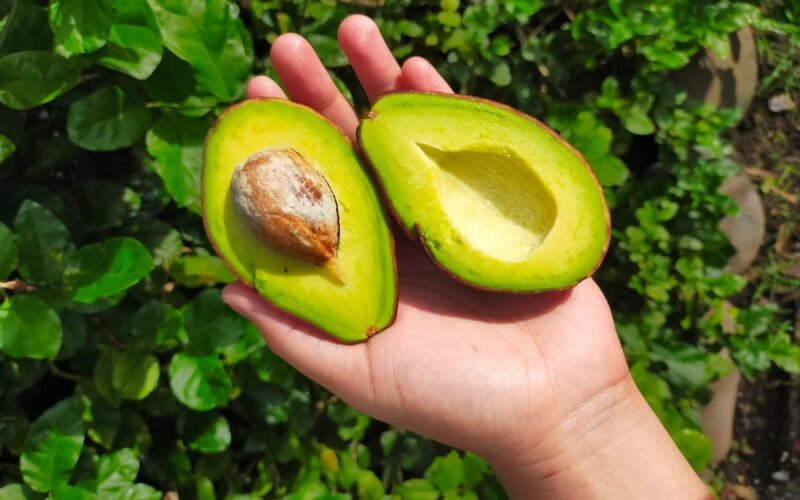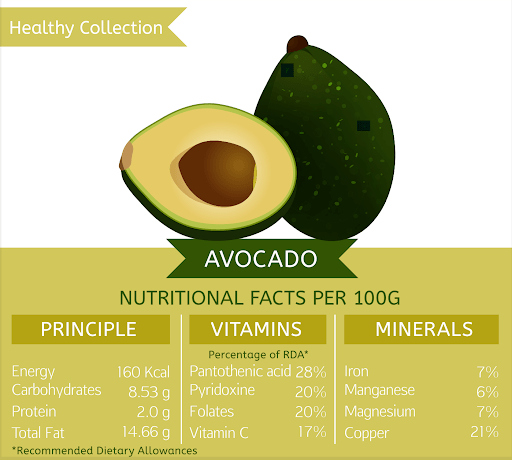How to Pick and Ripen the Perfect Avocado

She’s spreadable. A superfood. A chip dip. And she’s trendy on toast.
The avocado is a nutrient-dense, heart-healthy fruit. No matter how you slice them, avocados are pretty good for you.
But we know how hard it is to pick a ripe one. So we’re making the ultimate guide to finding the perfect avocado. Fear not, fruit-lover. We’ve avogotchu.
3 Easy Ways to Check If Your Avocado Is Ripe
- Color: Ripe avocados are dark green, almost black in color. If your avocado is bright green, chances are it won’t be ripe for a few days.
- Texture: The bumpier the avocado, the riper it is. Be careful, though: too bumpy or too bruised means you likely have an overripe avocado.
- Firmness: Apply gentle pressure to your avocado to check its firmness. If the avocado is hard as a brick, it’s not ripe yet. If you can softly press into the avocado and feel it give, you’re good to go.
Pro-Tip: You can also check the stem of your avocado to see if it’s ripe. Pop off the stem and check the inside color. If the color is brown, your avocado is definitely ripe. If the color is a lighter tan, give it a few days to ripen.
How to Ripen Avocados
If your avocado isn’t ripe yet, you can speed up the process with a few easy tricks:
- The Apple/Fruit Method: Place your avocado in a brown paper bag with an apple or banana. The apple or banana produces ethylene gas which helps ripen certain fruits like avocados more quickly.
- The iPhone Method: Uncooked rice isn’t just good for saving wet iPhones; it also produces ethylene gas. Place your avocado in a covered bowl of uncooked rice for a few days to speed up the ripening process as well.
- The Vitamin D Method: You can also place an avocado in the sun to help it ripen more quickly. Fruit actually ripens faster when exposed to warmer temperatures.
That’s great and all, but what if your avocado is too ripe?
Excellent question, avocado aficionado.
To slow down the ripening process, store your avocados in the fridge. It’s that simple. This goes for leftover avocados as well. You can wrap them in foil and refrigerate them to increase their shelf life.
And if you’re wondering how long avocados last, the answer is: it depends. Generally, unripe avocados last up to 7 days. Once ripe, you can refrigerate your avocados to help them stay ripe for an additional 3-5 days.
Now that you’ve got the basics, let’s look at some different avocado varieties.

Types of Avocados
There are many different types of avocados with different compositions and ripening characteristics. Let’s break them down starting with the most common:
Hass Avocados
These Mexican/Guatemalan hybrids are the ones you’re probably most familiar with. They are the most common avocados sold in American supermarkets.
- Key characteristics: Oval-shaped, thick, pebbled skin. When unripe, they’re a light lime green color. They’re higher in fat than other avocado varieties, but don’t let the macros scare you too much. These are monounsaturated fats, which can actually help reduce cholesterol levels.
- Hass avocado ripe color: Dark green, almost black.
Florida Avocados
Florida avocados are antillean hybrids. These avocados also represent an umbrella category for a bunch of different avocados, including Donnie, Dupuis, Hardee, Pollock, Simmonds, Russell, Lula, Choquette, and Monroe.
- Key characteristics: Larger with a smoother skin. Florida avocados have a lower fat content than Hass avocados, and they are sometimes advertised as “lite” avocados because of this.
- Florida avocado ripe color: Other than the Hardee variety, which turns deep red, Florida avocados remain green when they’re ripe. This means you have to rely on firmness, not color, to tell if they’re ripe. When their skin has a little give to it, they’re ready to enjoy.
Other Types of Avocados
- Fuerte, Ettinger, Reed, and Sharwill: These avocados also stay green when they’re ripe like Florida avocados.
Important distinctions between avocado varieties:
- Different types of avocados come with different flavors.
- Hass, Lamb Hass, Gwen, Reed, and Sharwil avocados have a creamier, nuttier flavor.
- Bacon and Zutano avocados have a lighter flavor.
- Different compositions:
- Hass, Pinkerton, Sharwil, and Fuerte avocados have the highest oil content of all the avocados.

How to Cut an Avocado
Now that your avocado is ripe, and you know what kind of avocado you’re working with, let’s tackle cutting your avocado safely:
- Place your avocado on the cutting board on its side.
- Hold the top of the avocado securely while you cut it lengthwise around the seed.
- Rotate both sides of the fruit to open the halves and reveal the pit.
- Use a spoon to scoop out the pit.
- If you want slices, cut the halves into quarters and gently scoop the avocado out of the skin.
- If you don’t need slices, you can scoop out the flesh of the avocado with a spoon.
If you’ve cut your avocado and you realize it’s not ripe enough, there’s no need to worry! You can save your avocado with the following steps.
- Rub lime or lemon juice on the flesh of the avocado.
- Squeeze the avocado halves back together.
- Wrap the avocado in plastic wrap/foil and place it in the fridge.
- Be sure to check on your avocado every day so you know when it has ripened!
Using Avocado as a Substitute
As we’ve mentioned, there are a variety of health benefits that avocados have to offer! Consider swapping ingredients with avocado for a more nutritional dish.
Mayonnaise
Skip the mayonnaise and use mashed avocado in recipes like tuna salad for a healthier alternative. By using avocado, you are replacing the saturated fats in mayonnaise with monounsaturated fats that help in lowering cholesterol. You’re also eliminating the sodium and preservatives which are found in mayonnaise.
Eggs
Believe it or not, avocado can be used as an egg replacement for a variety of recipes, including desserts! For every 1 egg, use 2 tbs. to a quarter cup of avocado.
You may need to experiment with this substitution to find just the right measurement. One thing to keep in mind is that the natural soft texture of the avocado tends to make cakes cave in the center and remain soft. If you appreciate a fudgy dessert, this will be no problem for you.
Butter/Oil
Rather than using butter or oil in desserts like cakes or brownies, try using avocado instead! The natural fattiness of the fruit will replace the butter without compromising the flavor.
Salad Dressing
If you’re looking for a dairy-free alternative to a creamy dressing, avocado is the answer. With just 1/2 of a ripe avocado, some herbs, and a squeeze of lemon, you can replace your sodium-filled dressing with a creamy and nutritional option.
Avocado Recipes to Try
Ingredients
- 1/4 c. all-purpose flour
- 1/4 c. cornmeal
- 1/2 tsp. chili powder
- 4 fish filets (1 lb.)
- 2 tbsp. canola oil
- 1/4 tsp. salt
- 8 corn tortillas, warmed
- 1/2 medium avocado
- 1/2 c. fresh pico de gallo, salsa verde, or picante sauce
- 1 medium lime
Fajita Chicken Wings with Avocado Dipping Sauce
Ingredients:
- 2 1/2 lbs. chicken wings
- 2 pkgs. of fajita or taco seasoning
- 3/4 c. ketchup
- 1/4 c. vegetable oil
- 1/4 c. Worcestershire sauce
- 1 tsp. salt
- 2 Hass avocados
- 1 pkg. ranch dressing mix
- 1/2 c. sour cream
- 1 tbsp. lemon juice
Frittata with Avocado, Roasted Peppers, Olives, and Feta
Ingredients
- 1/2 c. finely chopped onion
- 1 tsp. olive oil
- 8 large eggs
- 2/3 c. milk
- 3/4 tsp. dried leaf oregano
- 1/2 tsp. salt
- 2 avocados
- 2 tsp. fresh lemon juice
- 1 c. feta cheese
- 1/2 c. Kalamata olives
- 1/2 c. Fire-roasted sweet red bell peppers
Looking for fresh avocados sold locally? Check out our fresh foods store to get started!
This blog was originally published on April 29, 2019. It was updated on March 30, 2023.
